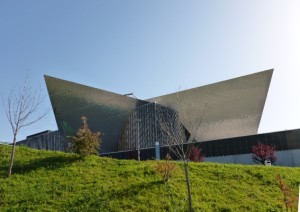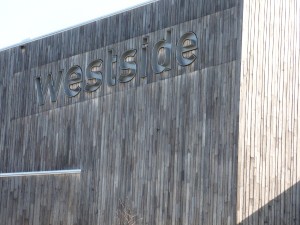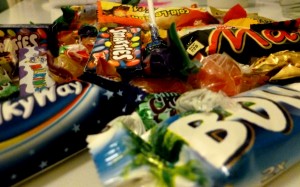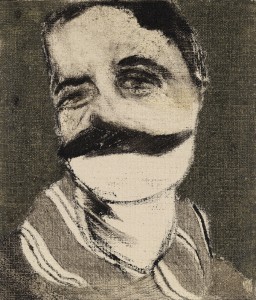 For enthusiasts of the Jewish Museum, excursions to other Libeskind buildings are imperative. Many are thematically related to the JMB, such as the Felix-Nussbaum-Haus in Osnabrück or the Jewish Museum in San Francisco. But equally worthwhile are the buildings designed for entirely other purposes, such as Westside, a suburban shopping mall completed in 2008 over a highway outside of Berne, Switzerland.
For enthusiasts of the Jewish Museum, excursions to other Libeskind buildings are imperative. Many are thematically related to the JMB, such as the Felix-Nussbaum-Haus in Osnabrück or the Jewish Museum in San Francisco. But equally worthwhile are the buildings designed for entirely other purposes, such as Westside, a suburban shopping mall completed in 2008 over a highway outside of Berne, Switzerland.
 The mall – despite, well, being a mall – shares many features with the Jewish Museum, which was Libeskind’s first building project. The well-trained, or perhaps overly-trained, eye may involuntarily pick up on architectural testimonies to German-Jewish history. → continue reading
The mall – despite, well, being a mall – shares many features with the Jewish Museum, which was Libeskind’s first building project. The well-trained, or perhaps overly-trained, eye may involuntarily pick up on architectural testimonies to German-Jewish history. → continue reading
Candy is a tricky matter for synagogues on Simhat Torah, the holiday celebrating the Torah and its yearly reading cycle. On this evening, the Torah scrolls are carried around the synagogue in festive processions and worshippers sing, dance, and throw sweets for children to collect.  In small synagogues, this procedure is fairly straightforward.
In small synagogues, this procedure is fairly straightforward.
But large synagogues can have issues with Milka-bars and Twixes flying through the air. To be fair, not many adults enjoy a barrage of caramels raining down on their heads, no matter the brand, no matter the degree of religious devotion. And to be very fair, bonbons thrown from synagogue balconies can be hazardous for the Torah scrolls, too. → continue reading

R.B. Kitaj, Portrait of Aby Warburg, 1958–1962 © R.B. Kitaj Estate
R.B. Kitaj is known for his expressive, strongly-colored paintings and the retrospective at the Jewish Museum does these qualities full justice. Though for me personally, one of the most appealing works was at first unprepossessing. It is very small, barely 15 x 13 cm, in shades of grey – more a study than a painting. The Portrait of Aby Warburg (1958) depicts the pioneer of methodical iconography, who lived from 1866 to 1929. The son of a Hamburg banker, who passed on a career in the family business in order to become an artist and art historian, Warburg was an important inspiration for the painter Kitaj. Warburg studied the afterlife of ancient motifs in Renaissance art, an interest Kitaj shared insofar as he systematically quoted artworks from past eras in his own paintings. → continue reading
 For enthusiasts of the Jewish Museum, excursions to other Libeskind buildings are imperative. Many are thematically related to the JMB, such as the Felix-Nussbaum-Haus in Osnabrück or the Jewish Museum in San Francisco. But equally worthwhile are the buildings designed for entirely other purposes, such as Westside, a suburban shopping mall completed in 2008 over a highway outside of Berne, Switzerland.
For enthusiasts of the Jewish Museum, excursions to other Libeskind buildings are imperative. Many are thematically related to the JMB, such as the Felix-Nussbaum-Haus in Osnabrück or the Jewish Museum in San Francisco. But equally worthwhile are the buildings designed for entirely other purposes, such as Westside, a suburban shopping mall completed in 2008 over a highway outside of Berne, Switzerland. The mall – despite, well, being a mall – shares many features with the Jewish Museum, which was Libeskind’s first building project. The well-trained, or perhaps overly-trained, eye may involuntarily pick up on architectural testimonies to German-Jewish history. → continue reading
The mall – despite, well, being a mall – shares many features with the Jewish Museum, which was Libeskind’s first building project. The well-trained, or perhaps overly-trained, eye may involuntarily pick up on architectural testimonies to German-Jewish history. → continue reading
